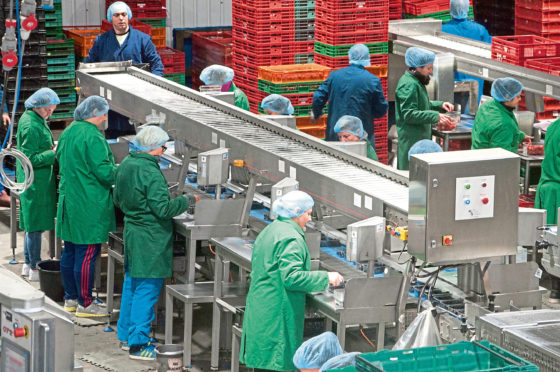The importance of securing an agricultural workforce and a Brexit deal with the EU was rammed home to new UK environment secretary Theresa Villiers on her first official visit north of the border.
Angus soft-fruit producer James Porter, who chairs NFU Scotland’s (NFUS) horticulture working group, reminded Ms Villiers the agri-food sector depends on a reliable workforce from outside the UK to fill seasonal and permanent posts across the supply chain, and called on her to convey that to her counterparts in the Home Office.
“NFUS is particularly concerned that the UK Government’s proposals in the event of no deal could expose those sectors that strongly depend on seasonal staff to severe shortages – an oversight which must be corrected, and soon,” he told Ms Villiers.
Perthshire cereals producer Ian Sands from Balbeggie, who chairs the union’s combinable crops committee, pointed out the need for a deal with the EU to enable free and frictionless trade to continue.
He also insisted the standards met by Scottish producers should not be undermined by cheap imported produce which fails to meet the same rigorous conditions.
He said: “Leaving the EU with no deal on October 31 will not give us that protection or opportunity, particularly if the UK Government’s proposed import tariff schedule is enacted in the event of no deal.”
He added that the proposals as they currently stand are set to “brutally expose key sectors – including cereals, oilseeds, eggs and horticulture – to the world market, running the risk of prices being undercut by cheaper imported produce produced to poorer standards”.
The meeting was hosted by Moray farm manager Martin Birse. He took Ms Villiers on a tour of Pitgaveny Farms, which produces cereals, beef, pork and lamb and lets out land for potatoes and carrots. Mr Birse said the uncertainty in the industry had never been higher.
“The malting barley we have grown on contract this year might make a small profit but for those forced to sell uncontracted malting barley on the spot market, the prices will come nowhere near production costs of around £150 to £160 per tonne and, without support, would be totally unsustainable,” he said.
“Beef breeding heifers that we were selling for £1,200 this time last year will struggle to make £1,000 this year as Brexit uncertainty continues to undermine the beef market, while leaving Europe without a deal would undoubtedly have massive implications for our sheep production in the future.”
NFUS vice-president Charlie Adam, said discussion centred on reasons why the devolved delivery of a fully-funded, targeted future support package is so important to Scottish agriculture.
nnicolson@thecourier.co.uk










